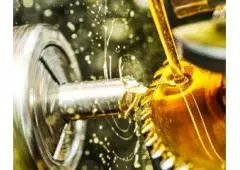Description
In the world of machining and metalworking, where precision and efficiency are paramount, the choice of cutting oil and its additives can significantly impact performance. Lubricity agents, also known as lubricants or friction modifiers, play a crucial role in cutting oil formulations, enhancing lubrication, reducing friction, and prolonging tool life during metal cutting operations. In this article, we'll explore the importance of lubricity agents in cutting oils, their functions, types, and benefits.
Understanding Lubricity Agents:
Lubricity agents are chemical additives designed to reduce friction and wear between cutting tools and workpiece materials during metal cutting processes. These additives form a protective film or boundary layer between the tool and the workpiece, minimizing metal-to-metal contact and heat generation. By enhancing lubrication and reducing friction, lubricity agents help improve surface finish, dimensional accuracy, and overall machining efficiency.
Functions of Lubricity Agents:
Friction Reduction: Lubricity agents reduce the coefficient of friction between the cutting tool and the workpiece, allowing for smoother cutting action and reduced wear on tool surfaces.
Heat Dissipation: By reducing friction and metal-to-metal contact, lubricity agents help dissipate heat generated during cutting operations, preventing tool overheating and thermal damage.
Chip Formation: Lubricity agents aid in the formation and evacuation of metal chips from the cutting zone, preventing chip buildup and promoting uninterrupted machining.
Tool Life Enhancement: By minimizing wear and heat generation, lubricity agents prolong the lifespan of cutting tools, reducing tool replacement costs and downtime.
Types of Lubricity Agents:
Extreme Pressure (EP) Additives: EP additives contain sulfur, phosphorus, or chlorine compounds that form protective films on metal surfaces under high-pressure and temperature conditions. These additives are effective in reducing wear and preventing metal-to-metal contact during heavy-duty machining operations.
Anti-Wear (AW) Additives: AW additives contain compounds such as zinc dialkyldithiophosphate (ZDDP) or molybdenum disulfide (MoS2) that provide anti-wear protection by forming solid lubricating films on metal surfaces. These additives are commonly used in cutting oils for moderate to heavy-duty machining applications.
Boundary Lubricants: Boundary lubricants, such as fatty acids, esters, or amine compounds, adhere to metal surfaces and form a protective boundary layer that reduces friction and wear. These lubricity agents are effective in low-speed, high-load machining operations.
Polar Additives: Polar additives, including fatty alcohols, amines, or esters, interact with metal surfaces through electrostatic or chemical interactions, enhancing lubrication and reducing friction. These additives are particularly effective in aluminum and other non-ferrous metal machining applications.
Benefits of Lubricity Agents:
- Improved Surface Finish: Lubricity agents help reduce tool wear and prevent surface defects, resulting in smoother surface finishes on machined components.
- Extended Tool Life: By minimizing friction and wear, lubricity agents prolong the lifespan of cutting tools, reducing tool replacement frequency and maintenance costs.
- Enhanced Machining Efficiency: Lubricity agents improve chip formation and evacuation, allowing for faster cutting speeds, higher feed rates, and increased productivity.
- Reduced Energy Consumption: By reducing friction and heat generation, lubricity agents contribute to energy savings and lower operating temperatures in machining processes.
Conclusion:
Lubricity agents are indispensable components of cutting oil formulations, playing a vital role in enhancing lubrication, reducing friction, and improving machining efficiency in metalworking applications. By carefully selecting and incorporating the appropriate lubricity agents into cutting oil formulations, manufacturers can achieve superior performance, extended tool life, and cost-effective machining solutions. In the ever-evolving landscape of metalworking, lubricity agents continue to pave the way for innovation, precision, and efficiency in machining operations.
Keywords: Lubricity Improver, Rust Inhibitor, Extreme Pressure Additives, Semi Synthetic Cutting Oil Additives, Anti Wear Additives, Metal Working Additives, Cutting Oil Additives, Eco Friendly Cutting Oil, Bounday Layer Lubricants, Additives for Synthetic MWF, Corrosion Inhibitor, Eco Friendly Metal Working Fluid, Just Add & Sell, Lubricity additive, Lubricity enhancer, Lubricity improver for metalworking fluids, Cutting oil lubricity improver, Lubricity Improver for coolant, Lubricity Improver, Lubricity Enhancer, Lubricity Additives, Lubricity Agent, Lubricity Improver for cutting oil, Lubricity Improver for metal working fluid, Lubricity Agent for cutting oil, Lubricity Agent for metal working fluid, Lubricity Agent for soluble oil, Lubricity agent for water based cutting oil, Cutting oil additive rust inhibitor, Rust inhibitor additive for metalworking fluids, Rust inhibitor additive for cutting oils, Rust inhibitor additive for water-soluble cutting oils, Water-soluble cutting oil additive rust inhibitor, Metalworking fluid extreme pressure additive, Cutting oil extreme pressure additive, EP additive for metalworking fluids, EP additive for cutting oils, Extreme pressure additive for metalworking fluids, Extreme pressure additive for cutting oils, Water-soluble cutting oil extreme pressure additive, EP additive for water-soluble cutting oils, Extreme pressure additive for water-soluble cutting oils, Anti-wear additives for metal working fluids, Anti-wear additives for water-based cutting oils, Anti-wear additives for soluble cutting oils, Anti-wear additives for water soluble cutting oils, Anti-wear additive for soluble cutting oil, Anti Wear Additive, Anti Wear Additive for metalworking fluids, Anti Wear Additive for cutting oils, Anti Wear Additive for coolant, Anti Wear Improver, Anti Wear Agent, Anti Wear Improver for cutting oil, Anti Wear Improver for metal working fluid, Anti Wear Agent for cutting oil, Anti Wear Agent for metal working fluid, Anti Wear Enhancer, Anti Wear Agent for soluble oil, Anti Wear agent for water based cutting oil, Metalworking fluid corrosion inhibitor, Cutting oil corrosion inhibitor, Water-soluble cutting oil corrosion inhibitor, Grinding fluid corrosion inhibitor, Corrosion inhibitor additive for metalworking fluids, Corrosion inhibitor additive for cutting oils, Corrosion inhibitor additive for water-soluble cutting oils, Cutting oil packages, Cutting oil emulsifiers, Cutting oil biocides, Cutting oil friction reducer, Cutting oil mist controllers, Cutting oil PH buffers, Component of cutting oil, Ingredients of cutting oil, Chemicals used in cutting oil, Eco-friendly cutting oil, Green cutting oil, Sustainable cutting oil, Environmentally friendly cutting oil, Biodegradable cutting oil, Green metalworking fluid, Sustainable metalworking fluid, Biodegradable metalworking fluid, Metal working additives, Additives for metal working, Metal working fluid additives, Metal working oil additives, Metal cutting oil additives, Metal forming additives, Metal grinding additives, Metal machining additives, Metalworking fluid additive rust inhibitor, Additive for Semi Synthetic Cutting oil, Semi Synthetic Cutting Oil additive, Additive for Synthetic Cutting oil, Synthetic cutting oil additive, Water-based cutting oil additives, Additives for water-based cutting oils, Additives for soluble cutting oil, Water soluble cutting oil additives, Additive for soluble cutting oil, Soluble cutting oil additives, Soluble cutting oil additive, Synthetic cutting oil formula, Formula of synthetic metal working fluid, Formulation of synthetic metal working fluids, What is synthetic metal working fluid, How to make semi synthetic cutting oil, How to make synthetic cutting oil, How to make synthetic metal working fluid, Friction Modifiers, Metal working additives, Formulations of metal working fluid, How to make metal working fluids, Metal Working Fluids Additives, Additives for metal working, Formula of synthetic metal working fluid, Formulation of synthetic metal working fluids, Synthetic cutting oil formulation, What is synthetic metal working fluid, How to make semi synthetic cutting oil, How to make synthetic cutting oil, How to make synthetic metal working fluid, Metal working additives, Formulations of metal working fluid, How to make metal working fluids, Metal Working Fluids Additives, How to make cutting oil, How to make cutting oil, Cutting fluid additives, Cutting oil formulations, Chemicals used in making cutting oil, Cutting oil formula, Formula of cutting oil, Additives required for making cutting oil, Cutting oil additive, Cutting oil formulation, Cutting oil package, Additive for Synthetic Metal Working Fluids, Synthetic metal working fluids Additive, Synthetic cutting oil additives, Additives for synthetic cutting oils, Additives for synthetic coolants,Synthetic MWF additives, Synthetic ester metalworking fluid, Low cost cutting oil, How to make cutting oil, Formulations of cutting oils, Chemicals used in cutting oil, Formulation of soluble cutting oil, Formulations of meta working fluids, Formulations of metal working fluids, How metal working fluids manufacturers, Contains of metal working fluid, Contains of cutting oil, Low cost metal working fluid, Economical cutting oil, Low price cutting oil, How to make cutting oil in home, Chemicals used in making cutting oil, Cutting oil package, Soluble cutting oil package, Eco friendly cutting oil, Green cutting oil, Eco metal working fluid 100, Eco friendly metal working fluid, Ester based metal working fluids, Vegetable oil based cutting oil, Biodegradable cutting oil, Vegetable-based cutting oil, Synthetic ester cutting oil, Biodegradable metalworking fluids, Vegetable-based metalworking fluids, Mineral oil free metal working fluids, Mineral oil free cutting oils, Amine free metal working fluids, Amine free rust inhibitor, Amine free corrosion inhibitor, Chlorinated paraffin free metal working fluids, Amine free cutting oils, Biodegradable metalworking fluids, Vegetable-based metalworking fluids, Synthetic ester metalworking fluids



















